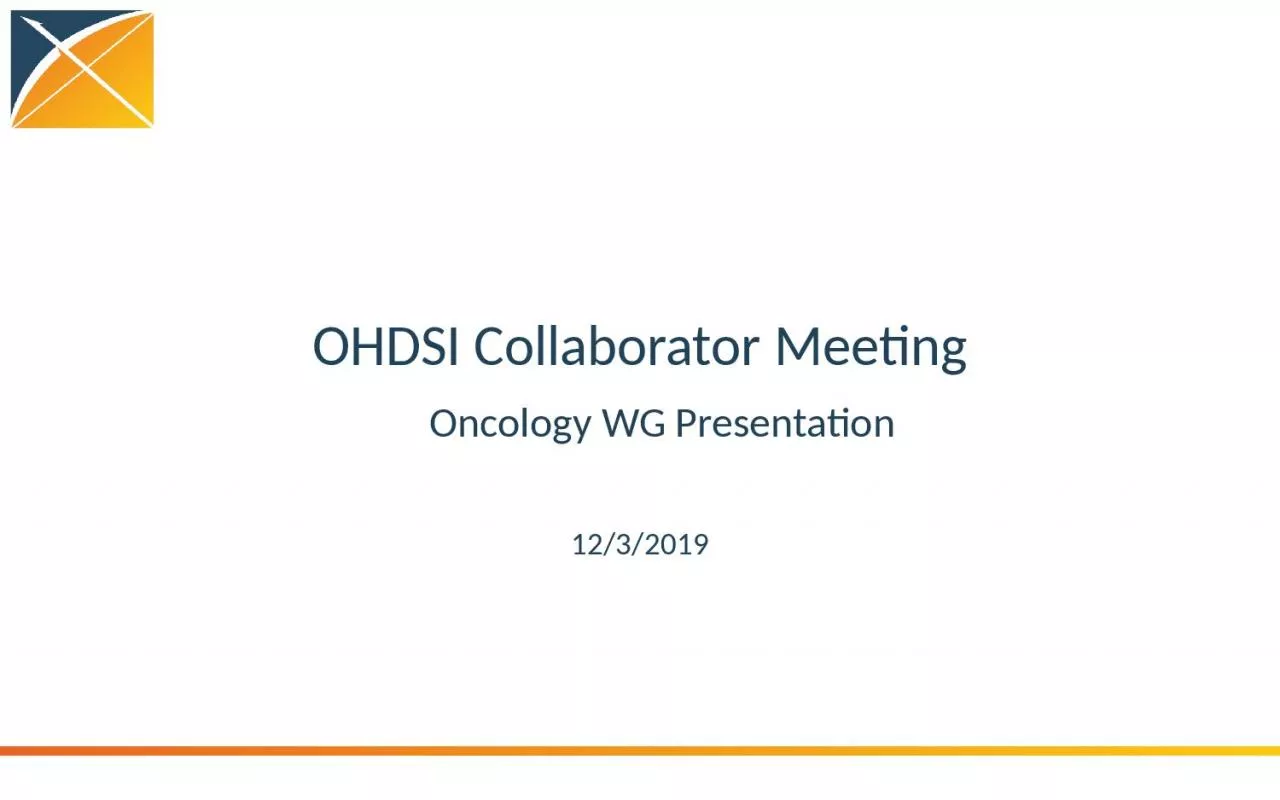

Oncology WG Presentation 1232019 Agenda Introduction to the Oncology WG Christian Whats Been Accomplished Rimma Next Steps MichaelMeeraDima Community Engagement in Development amp Research ID: 1041151
Download Presentation The PPT/PDF document "OHDSI Collaborator Meeting" is the property of its rightful owner. Permission is granted to download and print the materials on this web site for personal, non-commercial use only, and to display it on your personal computer provided you do not modify the materials and that you retain all copyright notices contained in the materials. By downloading content from our website, you accept the terms of this agreement.
1. OHDSI Collaborator MeetingOncology WG Presentation 12/3/2019
2. AgendaIntroduction to the Oncology WG (Christian)What’s Been Accomplished (Rimma)Next Steps (Michael/Meera/Dima)Community Engagement in Development & Research (Andrew)
3. Oncology WG Core TeamMichael GurleyChristian ReichRobert MillerJeremy WarnerAndrew WilliamsRuiJun ChenDmitry DymshytsRimma Belenkaya
4. ContributorsCharles Bailey, Children’s Hospital of PhiladelphiaScott Campbell, University of NebraskaRachel Chee, IQVIAMark Danese, Outcome InsightsAsieh Golozar, RegeneronGeorge Hripcsak, Columbia UniversityBen May, Columbia UniversityMaxim Moinat, The HyveAnna Ostropolets, Columbia UniversityMeera Patel, MSKJoseph Plasek, AuroraGurvaneet Randhawa, NCIMitra Rocca, FDAAnastasios Siapos, IQVIAFiras Wehbe, Northwestern UniversitySeng Chan You, Ajou University School of Medicine, Suwon, Korea
5. Data Standardization to OMOP Enables Systematic ResearchNorth America Southeast Asia ChinaEurope UK Japan IndiaSo Africa Switzerland Italy IsraelMortalityAdherenceSafety SignalsPredictionJapanNorth AmericaSoutheast AsiaChinaEuropeSwitzerlandItalyIndiaSo AfricaIsraelUKNot scalableNot transparentExpensiveSlowProhibitive to non-expert routine useAnalytical method: Adherence to DrugOne SAS or R script for each studyOMOPCDMOHDSIToolsOHDSI approachTraditional way
6. Cancer Research is different from other diseasesIt needs more detail:“What is the overall survival for patients with non-metastatic carcinoma of the neck of bladder in remission after first line of gemcitabin-containing chemotherapy?“Concepts in this research question currently not standardized:ConceptCategoryCarcinomaHistologyNeck of bladderAnatomical siteNon-metastatic diseaseTumor attributeDisease in remissionCondition EpisodeFirst line treatmentTreatment EpisodeChemotherapy regimenRegimenGemcitabinComponent of regimen
7. Five GoalsBuild standards on top of OMOPVocabularies Oncology ModuleData modelCreate algorithms and heuristicsInfer Disease Episodes (automatic abstraction)Infer chemo regimensBuild network of data nodesBuild network of researchersDo research7
8. Working Group DetailParticipantsOHDSIAjou UniversityAstraZenecaCenter for Surgical Science, Region SjaellandChildren’s Hospital of PennsylvaniaColumbia University Digital China HealthIntegraal Kankercentrum Nederland IQVIA Memorial Sloan Kettering Cancer CenterMerck MontefioreMount SinaiMultiple Myeloma FoundationNIHNorthwestern UniversityOdysseusOncology Analytics Pittsburgh UniversityProvidence HealthVanderbiltSubgroupsLeadership Outreach/Research Development CDM/Vocabulary Genomic Vocabularies implemented/under ConsiderationICD-O-3NAACCRCAP IMOHemOncOROT
9.
10. Use CasesSurvival OverallDisease-freeSymptom-freeFrom diagnosisFrom treatmentTime From diagnosis to treatmentFrom screening to diagnosis From symptoms/initial primary care visit to diagnosis Variations in outcomes of bladder cancer with and w/o liver metastasesDefine uptake of genomic testIdentify treatment regimens Compare tumor registry chemo with identified chemo regimens Validate identified chemo regimens against Beacon Compare uptake of newer medications vs. older medications Number of medications taken daily by a cancer patientSpeed of drug administrations and the risk of allergic reaction/rejectionTime of administration Comparative effectiveness of adhering to the administration rules vs deviations Metastatic hormone–sensitive prostate cancer and non-metastatic castration-resistant pros
11. What’s Been AccomplishedExtension of CDM and Vocabulary to support required granularity of cancer representationIncorporation of ICD-O into vocabularyIncorporation of NAACCR into vocabularyCDM support for cancer modifiersExtension CDM and Vocabulary to support abstractions required for cancer representationIncorporation of HemOnc into vocabulary Development of the Episode CDM moduleDevelopment of ETL from US Tumor Registries to OMOPTesting typical use cases
12. Challenges: GranularityNormal ConditionMost normal conditions are defined by three main dimensions implicitly, plus some extra attributesCancerCause is not known, but morphology and topology are detailed and explicitThe many tumor attributes (modifiers) are also explicit and well defined
13. Solving Granularity ChallengeCancer Diagnosis Model in the OMOP VocabularyAdded vocabularies:
14. Solving Granularity Challenge
15. Solving Granularity Challenge
16. Clinically and analytically relevant representation of cancer diagnoses, treatments, and outcomes requires data abstractionNot readily available in the source data Traditionally not supported in OMOP CDM Challenges: AbstractionDiagnosisHospice/EOLPalliative CareTreatments1st disease occurrence1st treatment courseRemission2nd treatment courseProgressionProgressionStable disease3rd and 4th treatment courses
17. Solving Abstraction ChallengeAdded vocabularies:
18. Solving Abstraction ChallengeAdded vocabularies:
19. TestingDeveloped ontology-driven ETL for data conversion from Tumor Registry Converted EHR and Registry data from four participating institutionsTested clinical characterization use casesSurvival from initial diagnosisTime from diagnosis to treatmentHigh-level treatment course for 1st cancer occurrenceDerivation of chemotherapy regimens from atomic drugs
20. ResultsSurvival from diagnosisTime from diagnosis to treatment
21. What You Can Do NowRepresent most granular cancer diagnosis based on ICD-OIngest Tumor Registry data using standardized ETLIdentify cancer patient cohorts based on multiple diagnostic featuresIngest or derive chemotherapy regimensIngest of derive cancer disease and treatment episodesTest existing use cases and implement your own
22. Next Steps – Development SubgroupDrug Regimen Algorithm and the challenge we plan to organize at the HackathonData quality checks for NAACCR ETLRobust NAACCR ETL including different dialectsAnalytical package and expansion with additional use casesAlgorithm for the identification of disease progression and other episodes
23. Next Steps – Vocabulary SubgroupDe-duplicate NAACCR variables and values and map duplicates to a selected primary codeIngest CAPCompare CAP variable-value pairs to NAACCR variable-value pairsMap NAACCR items (variables) and values to equivalent LOINC and SNOMED conceptsMap CAP items (variables) and values to LOINC and SNOMED concepts. Align this effort with the ongoing Nebraska Lexicon and CAP standardization efforts and with the evolving mCODE standard
24. Next Steps – Genomic Subgroup
25. Next Steps – Genomic Subgroup
26. Community Engagement in Development & ResearchData: US tumor registry, non-US tumor registry, EHR, Claims, trial (Future)Research questions: High impact use casesDomain modelers and vocab developers: Radiology, surgery, precision medicineETL developersMethodologists: Support of best practices
27. Questions?